ANCIENT ROMANS
Nordicists like to claim ancient cultures for Northern Europe, and attribute their decline to the absorption of slaves. To accomplish this they offer selective evidence and conjecture, while overstressing the significance of blondism. In the case of Rome, the data, as well as Roman statuary, shows that the producers of that culture were subracially mixed, with Alpine and Dinaric elements predominating, and that slavery must have had a negligible impact. Also, the culture's igniting spark came from the Etruscans, who were Mediterranean.
Anthropology
"...Keltic Iron Age type, which was a mixture of Nordic with Dinaric elements. ... mesocephalic and low-vaulted, with a prominent nose. ... On the whole, the Kelts were a mixed group in race as in culture; their ancestry includes both long heads of some central European Nordic type, which was in turn a combination of several Mediterranean sub-types, and brachycephals from the region in southwestern Germany in which the Dinarics of Early Bronze Age introduction had blended with earlier round heads of Mesolithic origin."...the movements from the north introduced Nordics of two varieties; the classic Hallstatt type, and the Keltic Iron Age type which was later to form the basic racial element among the Roman patricians.
"The early Romans, judging from the busts of their descendants in the days of Augustus, and of descriptions, were not very tall, as a rule, but were often of heavy body build. Their skulls were flattish on top, and rounded on the sides, like those of the Kelts. The facial features included the well-known "Roman" nose, which may have been partly derived from an Etruscan source. On the whole, the well-known sculptures of Caesar, Augustus, and others, although not reliable from the standpoint of accurate measurement, indicate that a mesocephalic to brachycephalic head form was admired. Their facial type is not native to the Mediterranean basin, but is more at home in the north [of the Alps]. Nevertheless, the Romans considered the Kelts who invaded Italy tall and blond; hence the blondism of the Romans, including rufosity, must have been in the minority."
Examples of modern representatives of the Keltic Nordic type, showing its many non-Nordic accretions:

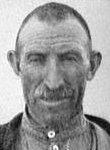

"...all anthropological evidence indicates that the Hellenes were a compost of ethnic strains (Angel), as were the Kelts (Powell; Coon), and that the Italici were predominantly Alpine (Whatmough; Sergi). ... Like the Latin flavi or the Greek xanthos, [the Sanskrit] hari is a generalized color term with a variety of alternate meanings. Xanthos, which our [Nordicist] translates, with equal certitude, as 'blond' was used, by the Greeks of antiquity, to designate 'any hair color short of jet black, and the color was in all probability not lighter than auburn' (Wace; similarly Keiter)."
"It is often supposed that blondness is an indication of Nordid ancestry. Taken by itself, it is nothing of the kind."* * *
* * *
"The universality of some degree of blondism among whites and near whites everywhere makes it unlikely that it was ever confined to a single race or group of races within the White family. ... [In Italy] blondism is everywhere correlated with a relatively high [i.e. Alpo-Dinaric] cephalic index."
(Coon, 1939)(Coon, 1951)
* * *
"The Mediterranean's hair is usually black or dark brown, while his whiskers may reveal a few strands of red or even blond. Blond hair may be seen, but it is the exception. Its presence does not require some invasion of Goths or Scyths or the miscegenation of Crusaders. One of the characteristics of the Mediterranean race is a minority tendency toward blondism. This is seen much more frequently in the eyes, since blond hair, which appears in infants, usually darkens as the hair coarsens with age."
Statuary
The Romans' round-headed Alpo-Dinaric character can be seen in the busts of illustrious (and typical) figures below. Even the few who may look superficially Nordic from the front invariably turn out, when viewed in profile, to have the short head and convex nose that exemplifies Dinarics.

Julius Caesar |
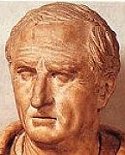
Cicero |
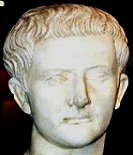
Nero |

Augustus |
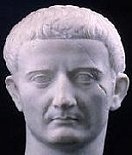
Tiberius |
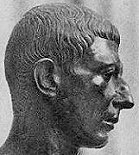
Cato the Elder |
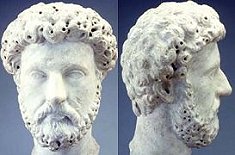
Marcus Aurelius (two views) |
|
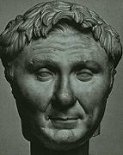
Pompey |
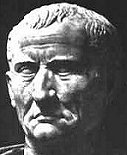
Galba |
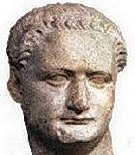
Domitian |
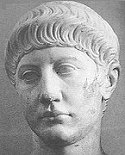
Otho |
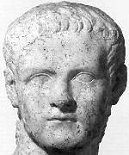
Caligula |
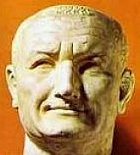
Vespasian |
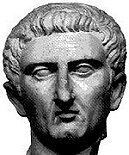
Nerva |
Slavery
"The proportion of blacks in the population of Roman Italy is, however, most unlikely to have been as high as in eighteenth century Britain (where the number of blacks has been estimated at between 20,000 and 30,000), even when one allows for exaggeration in the British figures and also subtracts from these figures a considerable number of so-called blacks whom no Roman would perceive as falling within the category Aethiops."
* * *
"The average recorded age at death for the slaves of the city of Rome was extraordinarily low: seventeen and a half years (17.2 for males; 17.9 for females)."
(Harper, 1972)
* * *
"However, one piece of negative evidence...provides an intriguing hint that conventional estimates of slaves making up as much as 40 percent of Italy's population by the late first century B.C. may be far too high. An analysis of the genetic makeup of Italy's modern population argues that the various distinctive genetic combinations currently found in different regions within the peninsula by and large track the linguistic distribution that resulted from the migrations of the Iron Age. No data indicate the subsequent large-scale infusion of new genetic material into the populations of these regions except in the case of southern Italy and eastern Sicily, which is explained by the well-documented Greek migrations there. ... But if a population of 3 million slaves, representing as much as 40 percent of Italy's inhabitants in the first century B.C., was successfully reproducing itself, it would surely have left its mark on the genetic makeup of contemporary Italians. That it did not argues strongly for a very low rate of natural reproduction among Italy's slaves, which in turn is difficult to reconcile with the hypothesis that the number of slaves ever grew large enough to comprise 40 percent of the Italian population."
Etruscans
"...the Romans, who were only villagers during the rise of the Etruscan civilization, were in close contact with the Etruscans, their language, their ideas, their religion, and their civilization; the Etruscans were the single most important influence on Roman culture in its transition to civilization."
* * *
"In Etruria lie the origins of Roman numerals and the Latin alphabet, tile roofs, aqueducts and basilicas, as well as portrait statues, giant sailing ships, and concepts of city planning."
* * *
"The Romans adopted many Etruscan customs over the years. They used the Etruscan alphabet, which the Etruscans had borrowed from the Greeks. The symbol of the Etruscan king's right to execute his subjects was a bundle of rods and an axe: the fasces (from which Mussolini created the Fascisti in the 20th century). The Romans even adopted the Etruscan toga. The vault and the arch were Etruscan in origin as were gladiatorial contests.
"Etruscan power and influence over the city of Rome was indeed strong and thanks to their trading interests, the city began to grow. By the mid-6th century, temples and public buildings could be found throughout the city. The Capitoline Hill became the religious center of the city and the Forum, formerly a cemetery, became a public meeting place, thus serving a similar role as the agora had at Athens."
* * *
Depictions of Etruscans, showing their Classic Mediterranean character:
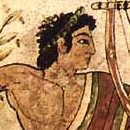
|
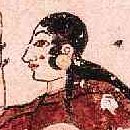
|
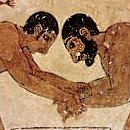
|
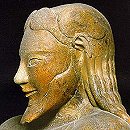
|
Related Topics
Italians: The identical subracial make-up of the modern people of Italy.
Caucasoid Subraces: See how Alpines, Dinarics and Mediterraneans differ from Nordics.
Nordicism Revisited (PDF): Read the entire anti-Nordicist article quoted from above.
Against Karl Earlson's "Nordic Hellas": Refuting similar claims about Ancient Greece.
